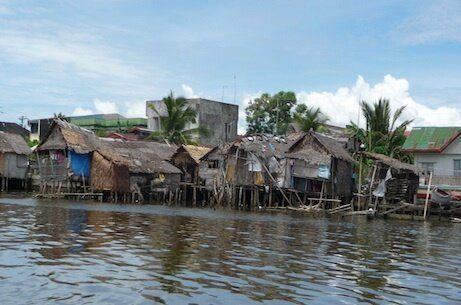
*Daniel Jimenez [2013] is doing an MPhil in Engineering for Sustainable Development at the University of Cambridge. Photo: Coastal homes along the path of Typhoon Haiyan prior to landfall, Basey, Samar, August 2013.
Over the past decade, the headlines have been full of stories of the Indian Ocean and Japanese Tsunamis, the earthquake in Haiti and Hurricane Katrina, with death tolls ranging from 1,800 in New Orleans to 200,000 in Indonesia. The magnitude of lost life is hard to comprehend. For most of the world's population, these tragedies - and others - are easy to forget when they are so far removed and life continues as normal. But what happens when tragedy hits close to home?
Typhoon Haiyan created major headlines last month when it became the world's strongest tropical storm at landfall with sustained winds at 195 mph. The death toll is now well above 5,000 and it is thus considered the deadliest typhoon in Philippine history. But the international media soon move on to other subjects.
Studying comfortably at Cambridge University, I find myself constantly reflecting on what role we can play as intellectuals and practitioners to support our fellow humankind and protect them from future tragedies. It is generally accepted that there is no such thing as a "natural disaster". Rather, humans are vulnerable to natural "hazards" because of the way we construct our environments. As we live in a collective society, many believe it is the responsibility of our institutions to provide the basic framework that ensures we have our needs met and the ability to provide for ourselves. Literacy, nutrition, peaceful governance, employment, protection from the elements; these are all tools through which we create the conditions for stability and opportunity and ensure that society does not fall victim to the wild forces of nature. If thousands of people are becoming victims of such hazards, with millions more displaced each year in the Philippines alone, it is clear that current policies, economies, social systems and technologies are failing to serve those who live on nature's frontline. Yet what can we do when these institutions fail?
Designing for the future
I spent the past year living and loving life in the Philippines, precisely to understand how I, as an engineer, could design the best buildings for the vulnerable and neglected in our societies. The Philippines is regarded by the UN as the third most susceptible nation to natural disasters, after Vanuatu and Tonga, two small Pacific island nations. A rather exhaustive list of earthquakes, typhoons, flash floods, volcanoes and tsunamis coupled with extreme population growth, urban density and poverty turn a perfect storm of hazards into disasters.
While the issue is undeniably complex, there is an important role the engineer can play so people can live in peace and safety rather than experience such extreme suffering. We can invent tools that are appropriate to the physical and economic environment in areas of particular vulnerability, tools that are accessible and provide options so people can protect themselves when greater institutions fail.
Engineering tools have overlooked a vast market where there is a glaring humanitarian need. The central Visayan islands of the Philippines are particularly vulnerable, with people living in inadequate infrastructure along shores and rivers that suit their seafaring lifestyle and idyllic island culture. Most people in the provinces build their homes out of local bamboo and while bamboo is naturally effective in seismic zones, many seek concrete houses as they don't suffer from rapid decay and insect infestation. However, as we learned from the Bohol earthquake three weeks before Typhoon Haiyan, these houses are usually built without proper seismic reinforcement and regulatory adherence. High-tech solutions for reinforced concrete and steel are often too expensive or just not available for these environments. Similarly, as I found, effective industrial tools to preserve bamboo and build in defense against typhoons just do not exist there.
Agent of change
Living in the provincial Philippines, much like anywhere else on Earth, people want to laugh, love, eat and live a meaningful life. We have a responsibility as designers and planners to give people the freedom to pursue the pleasures of life in a way that is sensitive to their surroundings. Engineering can be a way to encourage behaviour that suits different environments, as harsh or uplifting as they may be, so we must be careful to build in ways that work with those environments and that save lives when disaster strikes.
Hopefully, it won't take a disaster so close to home to encourage engineers, or anyone for that matter, to take action to change the way we perceive and thus build and live within our environments. This may be challenging, given our overwhelmingly busy lives and rushed, often unjust societies. But when you realise how easy it is to lose everything and everyone you love, when you watch from thousands of miles away as disaster unfolds in your home country, you reevaluate why we do what we do; whether it be for money, fame, honour, beauty or emotional freedom, for ourselves, our family, our community, our country, or for all the creatures of the world. Where do we draw the boundaries that divide us? What do we choose? What kind of world do we want to live in as we grow closer together in a world economy and global society? The challenge is to be an agent of change. If we are empowered in this way, we can empower others as well.
I choose to protect life by using my specialism of engineering to provide the tools that empower people to build safe homes for themselves and I hope that this may bring us freedom from undue suffering.
